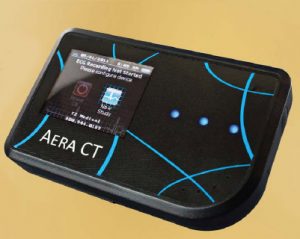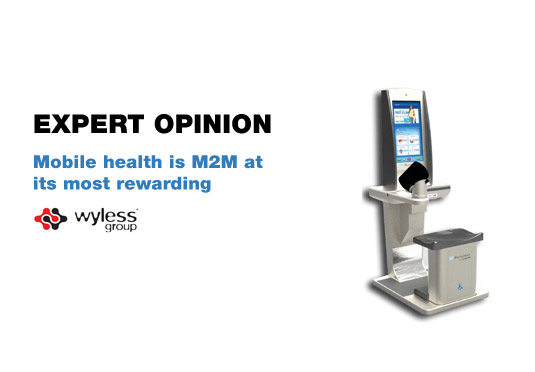Mobile health is M2M at its most rewarding. So says, Dan MacDuffie CEO of Wyless (left). And he should know, his managed services company has achieved 50% yearon- year growth recently and a growing portion of that is in mHealth and Wellness services. He’s certain we’re standing on the threshold of a new generation of health services that cut delivery costs, extend the reach of care givers, and bring new levels of care to patients. What is more, this growth is no longer confined to North America.
M2M Now: Dan, have we arrived at an mHealth tipping point?
Dan McDuffie: Yes, we have arrived. There is broad acceptance that mHealth reduces the overall cost of care and in the US business is accelerating. Sam Lucero of research house IHS indicates that revenues from connected healthcare services will have a CAGR of over 80% during the next few years.
In addition, there have been some large acquisitions, for example, Medtronics paid US$200m for Cardiocom. We’re also starting to see innovative solutions like VGo that take telemedicine to a brand-new level. Go to www.vgocom.com and you’ll see what I mean. Starting next year we will be powering this innovative new product on our 4G LTE Managed Network.
Advances in cellular technology, cost reductions in electronics and the growing need for remote management of atients have brought together a catalyst for long awaited innovations in mHealth. Over the next three to five years, remote homecare, self-diagnosing kiosks in pharmacies, and both personal and prescribed healthcare apps will become the
norm.
We’re a mobile society and mHealth is an integral component. There are numerous healthcare devices that monitor different conditions. In the past they were tethered to a landline connection: now the connections are wireless and that was the core competence that Wyless brought to this exciting M2M sector. In the last 12 months our mHealth revenues have more than doubled, which is another indication that the tipping point has been reached. It would probably be more accurate to say that we’ve passed that point.
M2M Now: Are smartphones and tablets set to play a key role?
DM: Yes, they are, in fact they’re already playing it. It’s a BYOD role that divides into fitness apps and preventative healthcare apps, but of course they’re related. If you download a fitness app that monitors your activity and another that measures your calorie intake then you are less likely to be overweight and develop diabetes or get a heart attack.
The FDA, the US Food and Drug Administration agency, says industry estimates predict that by 2015 there will be 500million smartphone users worldwide using healthcare applications. And by 2018, half the predicated 3.4 billion smartphone and tablet users will have downloaded at least one medical or health app.
It’s hard to overestimate the importance of this development. It encourages people to become engaged in their fitness and self-diagnosis, and helps minimise denial, which is potentially dangerous. There is a hypochondria angle, but I don’t think it’s significant. And self-diagnosis is timely, unlike an annual check-up, which is something that many people cannot afford. In a nutshell, BYOD technology is creating a very positive, holistic awareness of the importance of healthcare.
M2M Now: Can you summarise your company’s role? What added value does Wyless bring to the table?
DM: As I said earlier, our core competence is wireless, the clue is in the name of the company. Wyless is the leading provider of global M2M wireless connectivity solutions and managed services. As a service provider, we operate a global, secure managed network that layers ‘over the top’ of our MNO partners. It provides end-to-end managed services to enable our customers to easily deploy next generation services, including HIPAA compliant security, network SLAs, engineering services, consulting, and equipment lifecycle management.
Currently we have agreements with 19 leading MNOs, the latest being in Brazil. For our OEM partners we’re building an M2M bridge to a market in Brazil that is notoriously challenging to enter, but the potential market for mHealth there is huge.
However, we do a lot more than simply send biometric data back and forth over the airwaves. We partner with leading OEMs such as TZ Medical, who market arrhythmia monitoring devices, PharmaSmart, who are the world leader in the design, production, and distribution of innovative blood pressure screening systems and Cardiocom, who are a
leader in home health monitoring.
These companies, as well as many of our other partners, not just in the medical industry but across the M2M space have chosen Wyless as their supplier because of the broad range of services that they can get in one place, enabling them to deploy their solution more quickly and costeffectively. That’s why we built more and more services into our portfolio.
It’s also why we acquired ClearConnex in 2012. Their core competence is helping our partners develop devices and applications in around half the time and expense that a typical engineering services firm would take. In fact, one of their earliest projects was working with a company that provides heart monitoring systems. ClearConnex’s mantra is “start ahead, finish ahead” and it has gained significant traction, as covered in the October issue of M2M Now.
Wyless Connect is another business line and in this case the focus is around equipment lifecycle management, bundled with professional services, connectivity, even installation services, all of which has been a neglected aspect of the M2M industry. Our partners are now using us to configure, deploy and support the hardware that runs their solution. For example, we have facilitated the deployment of thousands of healthcare kiosks in drug stores and other retail locations. Most of these organisations won’t let kiosks and other ancillary connected devices onto their corporate network, so they need a secondary network for those customers. Cellular is clearly the optimum way to go for cost, convenience and installation: wireless days instead of several wireline months.
M2M Now: The greatest success in mHealth services so far has been in North America. Is there any evidence that healthcare providers elsewhere are catching up? Can you give examples?
DM: Success has been realised primarily through innovation, but the fact that the US represents a huge contiguous market is a contributing factor, as it is a fact that healthcare costs are high, probably the highest in the industrialised world. Minneapolis is a hotbed of mHealth innovation: it’s where major players such as Medtronics, Boston Scientific, and Cardiocom are headquartered.
Many European countries do their research and development work in the US prior to marketing the solution elsewhere. However, there are a number of very interesting homegrown developments. Buddi has a number of features that range from a simple alarm button, automatic fall alert and location. These features employ advanced satellite navigation technology to pinpoint a wearer’s location and a Wyless service is then used to communicate between the buddi and a fully staffed, 24/7 emergency monitoring centre. And this product is now coming into the USA from the UK where it was developed.
I think of the States as a global incubator. We’re also seeing more and more partners doing trials outside the States and of course when it comes to deployment they can use the same managed communication service as well as the lifecycle and project management services that they rely on Wyless to provide in the USA.
M2M Now: You recently gave a presentation at MobileCON. Can you cover the highlights?
DM: The title was ‘Bringing the doctor to the patient’ and it is exemplified in PharmaSmart’s blood pressure screening systems, which can be used in the kiosks Wyless helped install in large retail outlets. These systems are employed in pharmacies, worksites, and medical clinics across North America, administering over 65 million BP tests each year.
However, the solution that literally brings the doctor to the patient is VGo’s robotic presence solution that I mentioned earlier. VGo replicates a person – patient as well as doctor – in a distant location and the communications functionality is both hightouch as well as high-tech. It allows users to see, hear, talk and move around as if you were there.

M2M Now: How do you see the future? Where will Wyless be in five year’s time?
DM: I see a very positive future and I’m not looking through rose-tinted glasses. Analysts are predicting an mHealth CAGR of between 60% and 80% and Wyless is doing its level best to match that figure. We’ve been growing at more than 50% year-onyear and we expect to meet and exceed that figure well into the future.
We will continue to invest in this sector as well as many others. However, I’d like to conclude on a different note: M2M brings significant benefits to everyday life via key verticals like energy monitoring, telematics and much, much more, but helping to create mHealth care solutions is something extra special because it’s about helping people to live a better life. This is M2M at its truly most rewarding, and that’s what keeps me so focused on building Wyless into a world class company, in service to such lofty goals.










